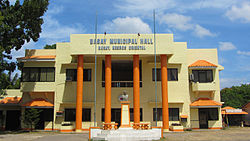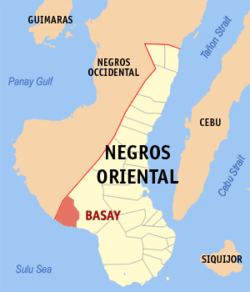Basay, officially the Municipality of Basay, is a 4th class municipality in the province of Negros Oriental, Philippines. According to the 2020 census, it has a population of 28,531 people.[3]
Basay | |
|---|---|
| Municipality of Basay | |
 Municipal Hall | |
 Map of Negros Oriental with Basay highlighted | |
Location within the Philippines | |
| Coordinates: 9°25′N 122°38′E / 9.42°N 122.63°E | |
| Country | Philippines |
| Region | Negros Island Region |
| Province | Negros Oriental |
| District | 3rd district |
| Founded | June 15, 1968 |
| Named for | Visayan term "busay", meaning "spring" |
| Barangays | 10 (see Barangays) |
| Government | |
| • Type | Sangguniang Bayan |
| • Mayor | Fatima C. Cañamaque (NPC) |
| • Vice Mayor | Jonny A. Wagas (IND) |
| • Representative | Vacant (Martin Romualdez serves as legislative caretaker) |
| • Municipal Council | Members |
| • Electorate | 20,506 voters (2022) |
| Area | |
• Total | 162.00 km2 (62.55 sq mi) |
| Elevation | 74 m (243 ft) |
| Highest elevation | 686 m (2,251 ft) |
| Lowest elevation | 0 m (0 ft) |
| Population (2020 census)[3] | |
• Total | 28,531 |
| • Density | 180/km2 (460/sq mi) |
| • Households | 6,984 |
| Economy | |
| • Income class | 4th municipal income class |
| • Poverty incidence | 40.12 |
| • Revenue | ₱ 120.9 million (2020) |
| • Assets | ₱ 220.8 million (2020) |
| • Expenditure | ₱ 113.9 million (2020) |
| • Liabilities | ₱ 38.07 million (2020, 2019) |
| Service provider | |
| • Electricity | Negros Oriental 2 Electric Cooperative (NORECO 2) |
| Time zone | UTC+8 (PST) |
| ZIP code | 6222 |
| PSGC | |
| IDD : area code | +63 (0)35 |
| Native languages | Cebuano Tagalog Hiligaynon |
The town is home to the highly significant Minagahat language, the indigenous language of Southern Negros as listed by the Komisyon ng Wikang Filipino. The language is vital to the culture and arts of the people.
Basay is 122 kilometres (76 mi) from Dumaguete.
Etymology
editThe name stems from the abundance of natural springs in the area, which are locally called "busay." The name was later changed from "Busay" to "Basay" during the Spanish era for unknown reasons.[5]
History
editBasay was created under the Republic Act No. 5491, which was signed in 1968.[6] Upon its separation from Bayawan in 1971, Basay became Oriental Negros’ westernmost town, with Negros Occidental at its rear. Diocesan chronicles reveal that it was already a far-flung outpost in the nineteenth century. It perked up in the 70s when CDCP and INKO arrived to mine its copper and iron magnetite.
Basay is agricultural, with sugar cane, rice, corn and copra as major crops. Fringing its shoreline is the Mindanao Sea, considered the richest fishing waters in the country.
Three major rivers running parallel from north to south traverse the town. Balatong Point, also known as Punta Tambongon, was the landing site of a submarine bearing the biggest shipment of WWII ammunition for Negros Oriental. The party was headed by Col Jesus Villamor, acting on the personal direction of Gen Douglas MacArthur who was then in Australia.
The coves and shallow caves on the shoreline of Nagbo-alao are said to be enchanted. The Negros cave frog is endemic to Basay. Its Pagatban River is home to the alligator. Bal-os and Cabcaban springs are important sources of potable water as well as sunny picnic sites. Yardahan is a fishing village with fine swimming areas and game-fishing activities.
Basay is approximately a two-hour-and-a-half drive from Dumaguete.[7]
Geography
editBasay is located in the south of Negros Island on the coast of the Sulu Sea.
Barangays
editBasay is politically subdivided into 10 barangays. Each barangay consists of puroks and some have sitios.
| PSGC | Barangay | Population | ±% p.a. | |||
|---|---|---|---|---|---|---|
| 2020[3] | 2010[8] | |||||
| 074605001 | Actin | 8.4% | 2,407 | 2,391 | 0.07% | |
| 074605002 | Bal-os | 14.6% | 4,172 | 3,225 | 2.61% | |
| 074605003 | Bongalonan | 14.7% | 4,185 | 3,742 | 1.12% | |
| 074605004 | Cabalayongan | 3.1% | 878 | 1,110 | −2.32% | |
| 074605005 | Cabatuanan | 3.4% | 967 | 741 | 2.70% | |
| 074605006 | Linantayan | 2.9% | 834 | 1,250 | −3.97% | |
| 074605007 | Maglinao | 11.3% | 3,216 | 2,807 | 1.37% | |
| 074605008 | Nagbo-alao | 19.4% | 5,546 | 4,050 | 3.19% | |
| 074605009 | Olandao | 3.9% | 1,119 | 1,094 | 0.23% | |
| 074605010 | Poblacion | 18.3% | 5,207 | 4,503 | 1.46% | |
| Total | 28,531 | 24,913 | 1.37% | |||
Climate
edit| Climate data for Basay, Negros Oriental | |||||||||||||
|---|---|---|---|---|---|---|---|---|---|---|---|---|---|
| Month | Jan | Feb | Mar | Apr | May | Jun | Jul | Aug | Sep | Oct | Nov | Dec | Year |
| Mean daily maximum °C (°F) | 31 (88) |
31 (88) |
32 (90) |
33 (91) |
31 (88) |
30 (86) |
29 (84) |
29 (84) |
29 (84) |
29 (84) |
30 (86) |
30 (86) |
30 (87) |
| Mean daily minimum °C (°F) | 22 (72) |
22 (72) |
22 (72) |
24 (75) |
25 (77) |
25 (77) |
25 (77) |
25 (77) |
25 (77) |
25 (77) |
24 (75) |
23 (73) |
24 (75) |
| Average precipitation mm (inches) | 46 (1.8) |
45 (1.8) |
56 (2.2) |
83 (3.3) |
163 (6.4) |
203 (8.0) |
236 (9.3) |
204 (8.0) |
210 (8.3) |
211 (8.3) |
143 (5.6) |
77 (3.0) |
1,677 (66) |
| Average rainy days | 12.1 | 9.8 | 14.3 | 17.5 | 26.0 | 27.8 | 28.4 | 26.9 | 26.7 | 27.9 | 23.3 | 17.2 | 257.9 |
| Source: Meteoblue (Use with caution: this is modeled/calculated data, not measured locally.)[9] | |||||||||||||
Demographics
edit| Year | Pop. | ±% p.a. |
|---|---|---|
| 1970 | 8,235 | — |
| 1975 | 13,974 | +11.19% |
| 1980 | 21,637 | +9.13% |
| 1990 | 17,736 | −1.97% |
| 1995 | 18,500 | +0.79% |
| 2000 | 21,366 | +3.14% |
| 2007 | 22,713 | +0.85% |
| 2010 | 24,913 | +3.42% |
| 2015 | 26,566 | +1.23% |
| 2020 | 28,531 | +1.41% |
| Source: Philippine Statistics Authority[10][8][11][12] | ||
Economy
editPoverty incidence of Basay
10
20
30
40
50
60
2006
50.90 2009
45.79 2012
46.43 2015
53.31 2018
29.10 2021
40.12 Source: Philippine Statistics Authority[13][14][15][16][17][18][19][20] |
Education
editThe public schools in the town of Basay are administered by one school district under the Schools Division of Bayawan City.
Elementary schools:
- Basay Central School — Burgos Street, Poblacion
- Bongalonan Elementary School — Bongalonan
- Cabalayongan Elementary School — Sitio Cansan-a, Cabalayongan
- Cabatuanan Elementary School — Cabatuanan
- Cabigti-an Elementary School — Sitio Cabigti-an, Maglinao
- Cleomenes Consolacion Fortugaleza Memorial Elementary School (formerly Actin ES) — Actin
- Datag Elementary School — Sitio Datag, Maglinao
- Don Pablo Carmen Blanco Utzurrum Memorial Elementary School — Nagbo-alao
- Linantayan Elementary School — Linantayan
- Maglinao Elementary School — Maglinao
- Monsale Elementary School — Bal-os
- Olandao Elementary School — Olandao
- Tiabanan Valley Elementary School — Sitio Sandig, Bongalonan
High schools:
- Andres V. Fortugaleza National High School (formerly Actin NHS) — Actin
- Bal-os National High School — Bal-os
- Basay National High School — Sitio Daro, Nagbo-alao
- Maglinao National High School — Maglinao
References
edit- ^ Municipality of Basay | (DILG)
- ^ "2015 Census of Population, Report No. 3 – Population, Land Area, and Population Density" (PDF). Philippine Statistics Authority. Quezon City, Philippines. August 2016. ISSN 0117-1453. Archived (PDF) from the original on May 25, 2021. Retrieved July 16, 2021.
- ^ a b c Census of Population (2020). "Region VII (Central Visayas)". Total Population by Province, City, Municipality and Barangay. Philippine Statistics Authority. Retrieved 8 July 2021.
- ^ "PSA Releases the 2021 City and Municipal Level Poverty Estimates". Philippine Statistics Authority. 2 April 2024. Retrieved 28 April 2024.
- ^ "Basay - History". Retrieved July 9, 2024.
- ^ "REPUBLIC ACT No. 5421 - An Act Creating the Municipality of Basay in the Province of Negros Oriental". Retrieved July 9, 2024.
- ^ "About | Cities & Towns Archived 2014-02-19 at the Wayback Machine", Negros Oriental Tourism Office. Retrieved 2013-05-28.
- ^ a b Census of Population and Housing (2010). "Region VII (Central Visayas)" (PDF). Total Population by Province, City, Municipality and Barangay. National Statistics Office. Retrieved 29 June 2016.
- ^ "Basay: Average Temperatures and Rainfall". Meteoblue. Retrieved 6 May 2020.
- ^ Census of Population (2015). "Region VII (Central Visayas)". Total Population by Province, City, Municipality and Barangay. Philippine Statistics Authority. Retrieved 20 June 2016.
- ^ Censuses of Population (1903–2007). "Region VII (Central Visayas)". Table 1. Population Enumerated in Various Censuses by Province/Highly Urbanized City: 1903 to 2007. National Statistics Office.
- ^ "Province of". Municipality Population Data. Local Water Utilities Administration Research Division. Retrieved 17 December 2016.
- ^ "Poverty incidence (PI):". Philippine Statistics Authority. Retrieved December 28, 2020.
- ^ "Estimation of Local Poverty in the Philippines" (PDF). Philippine Statistics Authority. 29 November 2005.
- ^ "2003 City and Municipal Level Poverty Estimates" (PDF). Philippine Statistics Authority. 23 March 2009.
- ^ "City and Municipal Level Poverty Estimates; 2006 and 2009" (PDF). Philippine Statistics Authority. 3 August 2012.
- ^ "2012 Municipal and City Level Poverty Estimates" (PDF). Philippine Statistics Authority. 31 May 2016.
- ^ "Municipal and City Level Small Area Poverty Estimates; 2009, 2012 and 2015". Philippine Statistics Authority. 10 July 2019.
- ^ "PSA Releases the 2018 Municipal and City Level Poverty Estimates". Philippine Statistics Authority. 15 December 2021. Retrieved 22 January 2022.
- ^ "PSA Releases the 2021 City and Municipal Level Poverty Estimates". Philippine Statistics Authority. 2 April 2024. Retrieved 28 April 2024.


